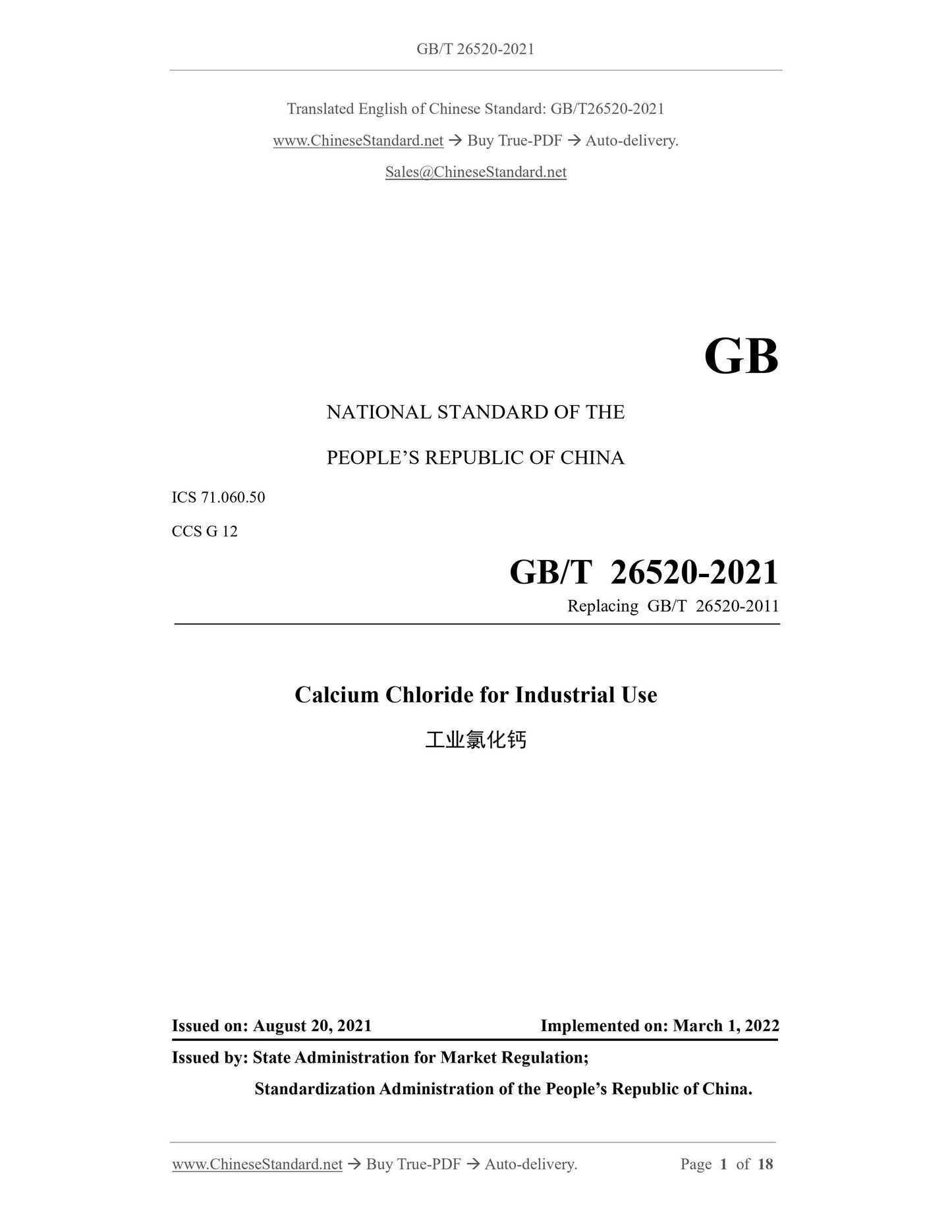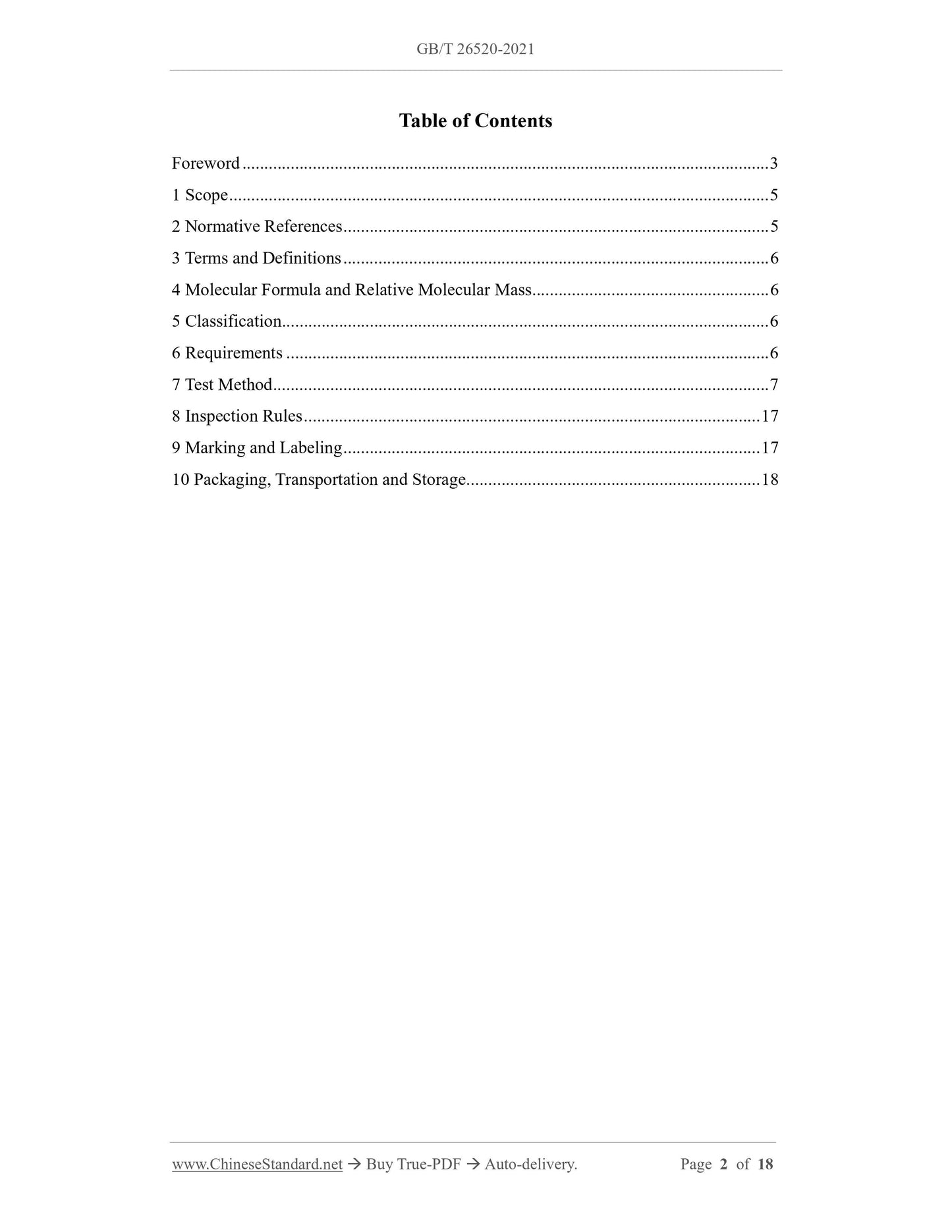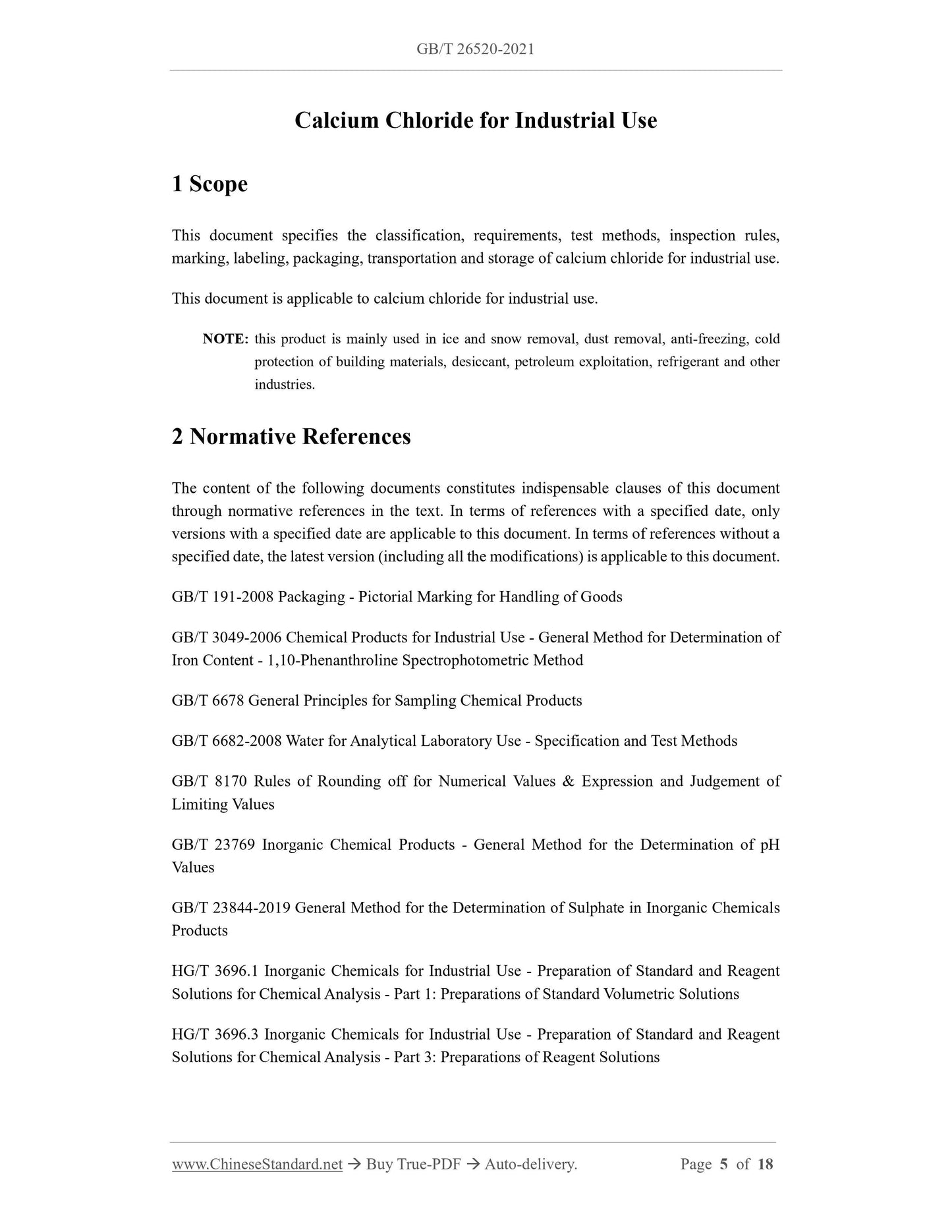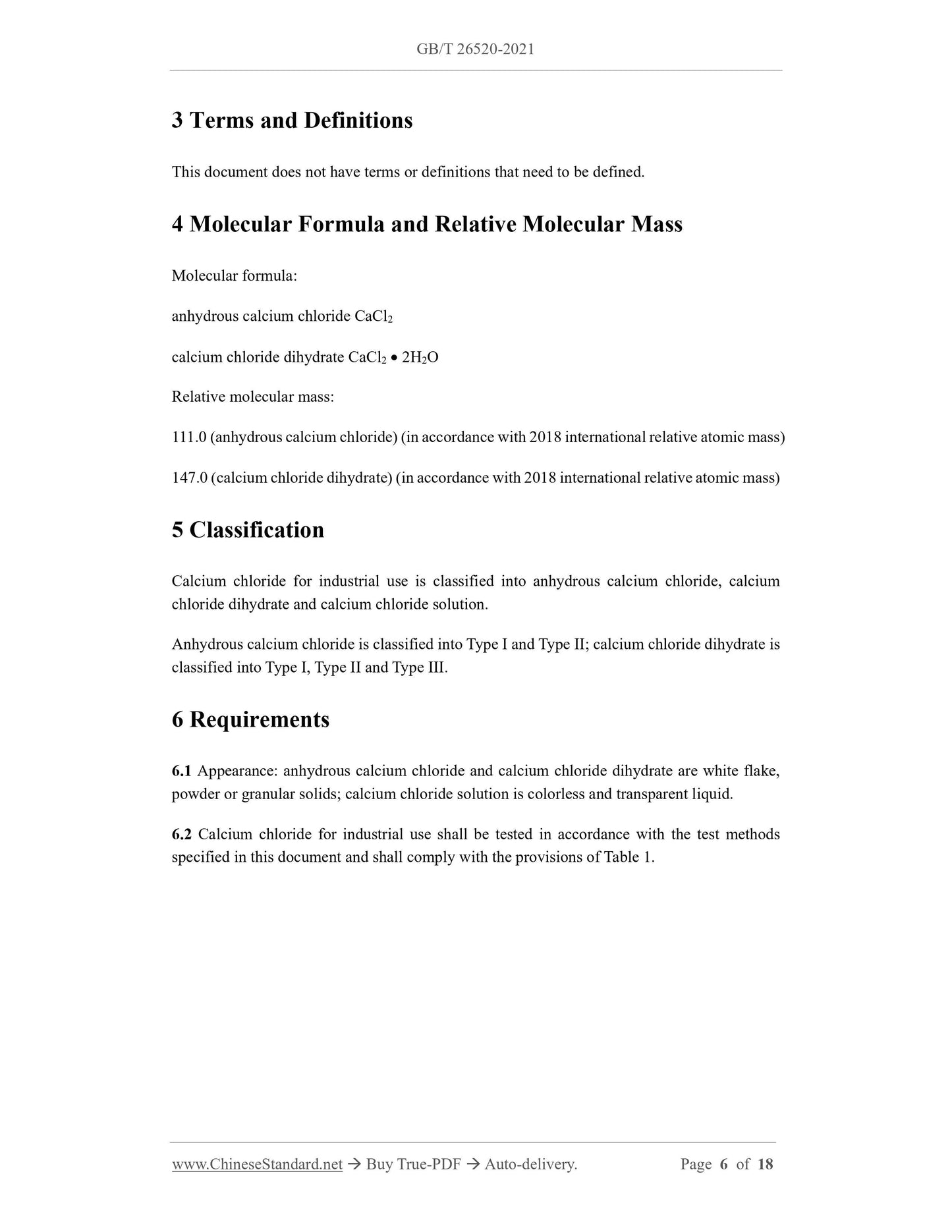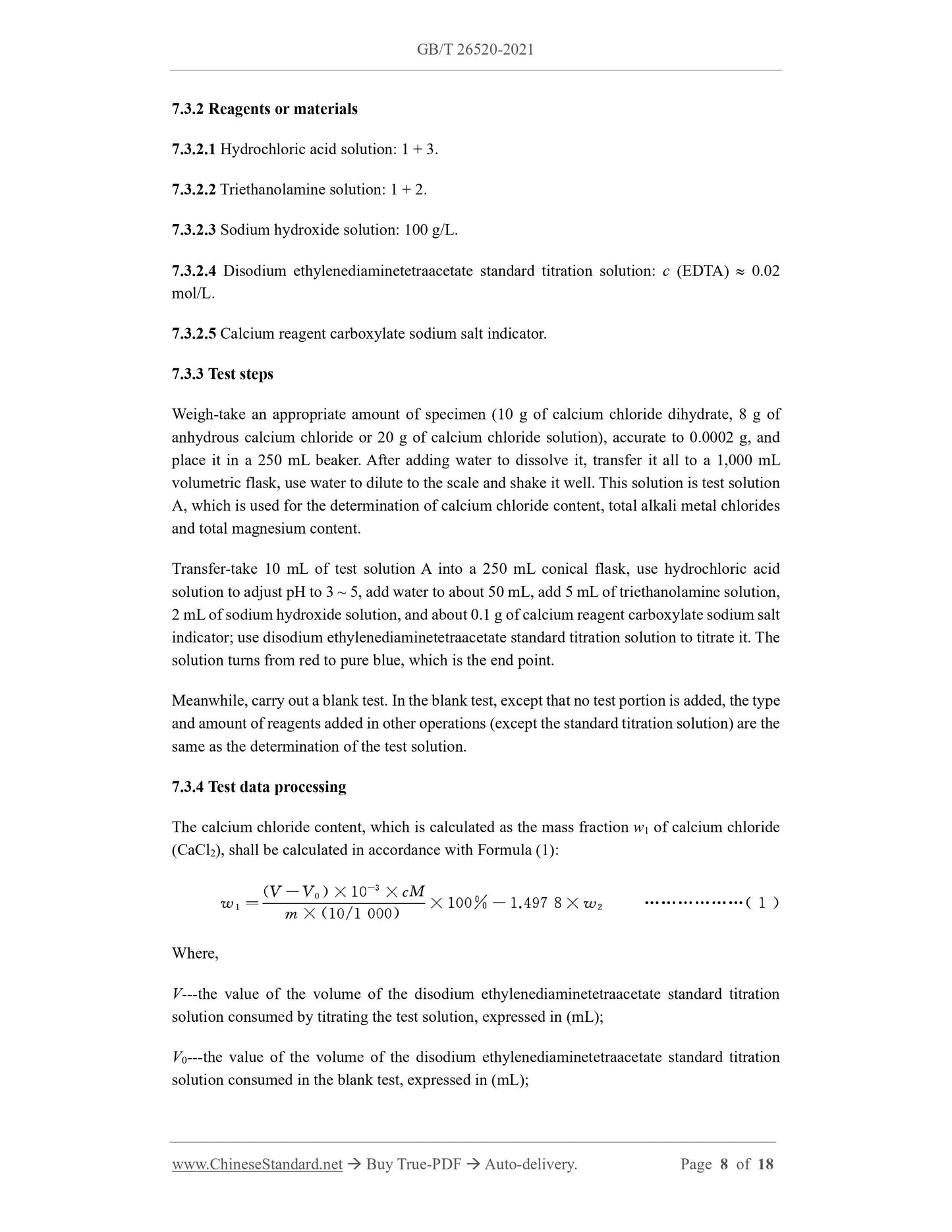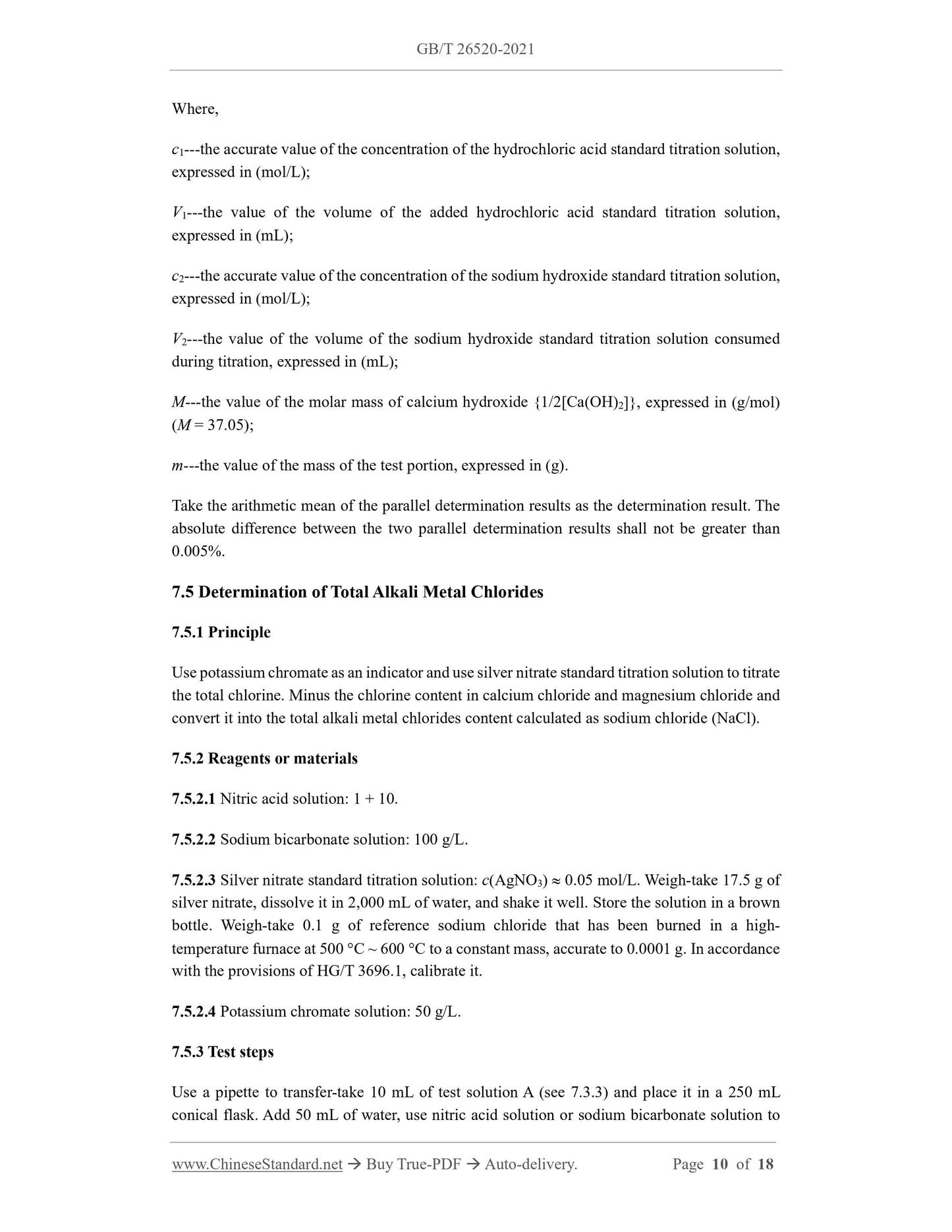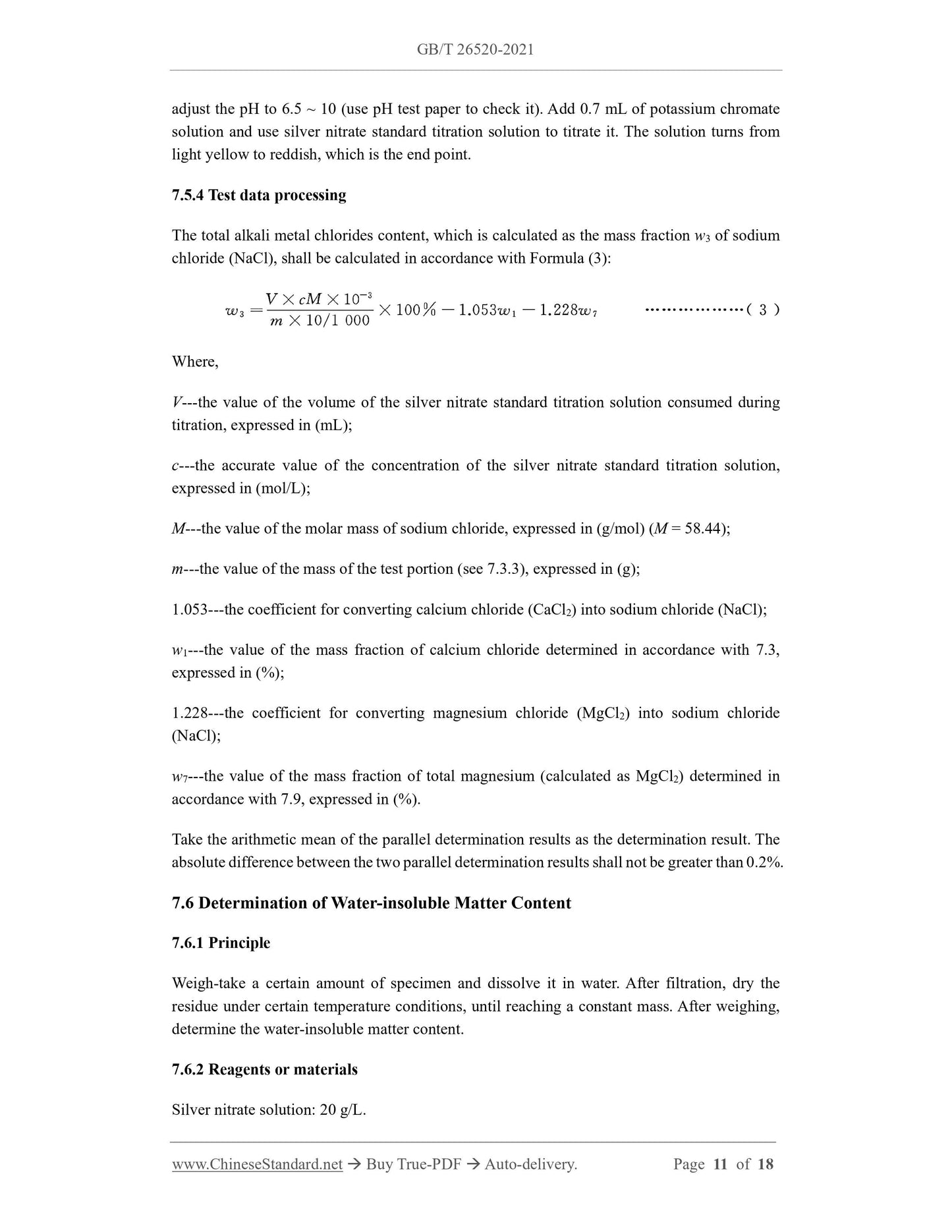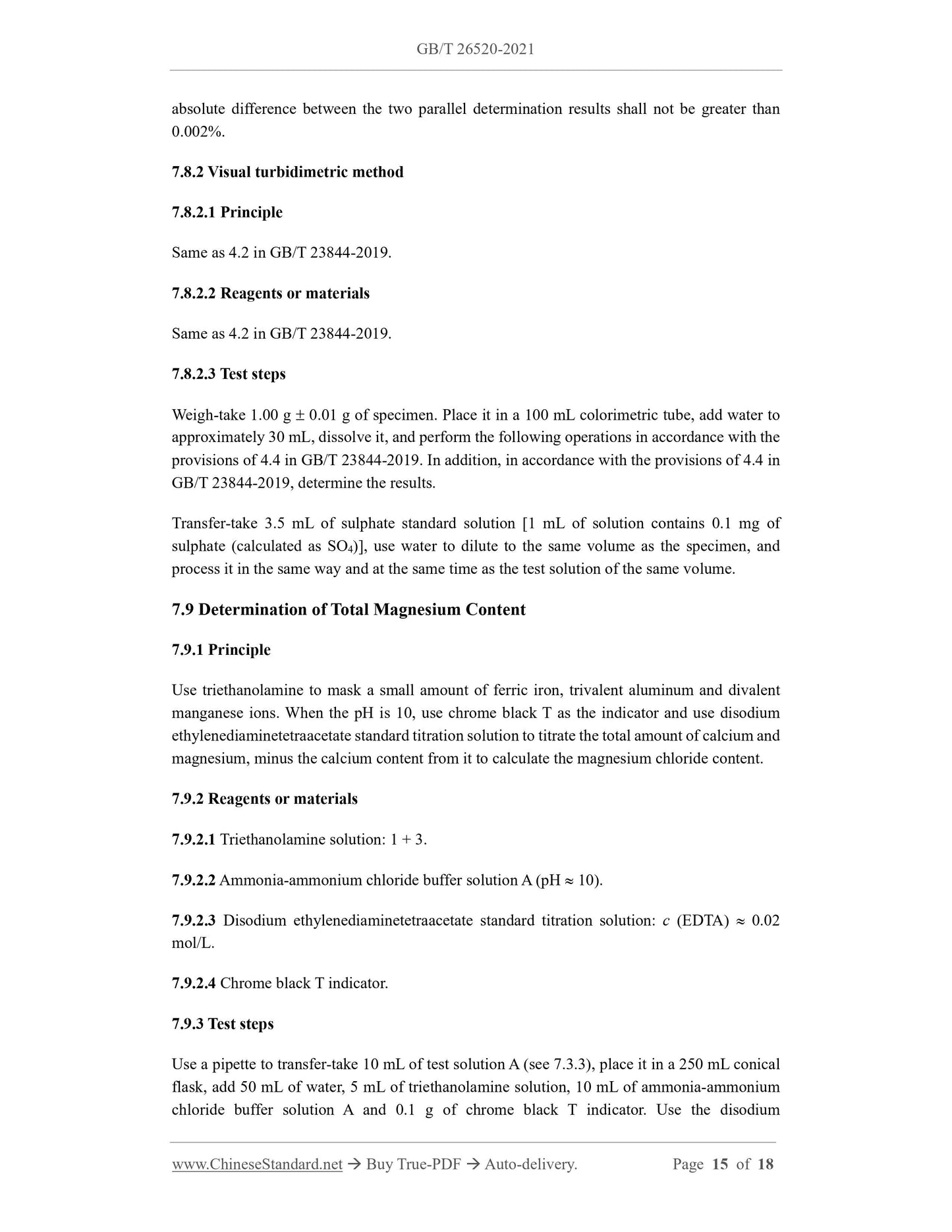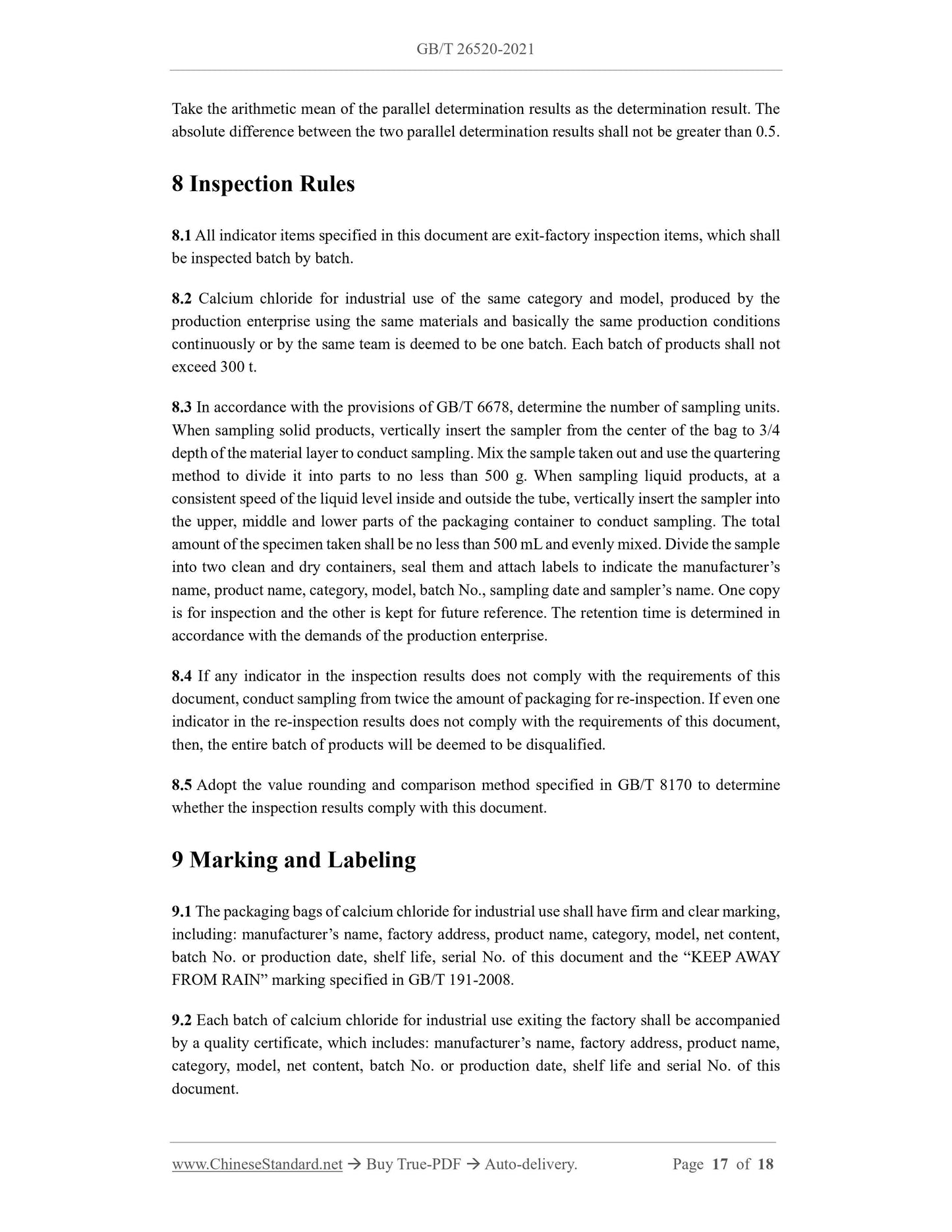1
/
de
9
PayPal, credit cards. Download editable-PDF and invoice in 1 second!
GB/T 26520-2021 English PDF (GBT26520-2021)
GB/T 26520-2021 English PDF (GBT26520-2021)
Prix habituel
$140.00 USD
Prix habituel
Prix promotionnel
$140.00 USD
Prix unitaire
/
par
Frais d'expédition calculés à l'étape de paiement.
Impossible de charger la disponibilité du service de retrait
Delivery: 3 seconds. Download true-PDF + Invoice.
Get QUOTATION in 1-minute: Click GB/T 26520-2021
Historical versions: GB/T 26520-2021
Preview True-PDF (Reload/Scroll if blank)
GB/T 26520-2021: Calcium chloride for industrial use
GB/T 26520-2021
GB
NATIONAL STANDARD OF THE
PEOPLE’S REPUBLIC OF CHINA
ICS 71.060.50
CCS G 12
Replacing GB/T 26520-2011
Calcium Chloride for Industrial Use
工业氯化钙
ISSUED ON: AUGUST 20, 2021
IMPLEMENTED ON: MARCH 1, 2022
Issued by: State Administration for Market Regulation;
Standardization Administration of the People’s Republic of China.
Table of Contents
Foreword ... 3
1 Scope ... 5
2 Normative References ... 5
3 Terms and Definitions ... 6
4 Molecular Formula and Relative Molecular Mass ... 6
5 Classification ... 6
6 Requirements ... 6
7 Test Method ... 7
8 Inspection Rules ... 17
9 Marking and Labeling ... 17
10 Packaging, Transportation and Storage ... 18
Calcium Chloride for Industrial Use
1 Scope
This document specifies the classification, requirements, test methods, inspection rules,
marking, labeling, packaging, transportation and storage of calcium chloride for industrial use.
This document is applicable to calcium chloride for industrial use.
NOTE: this product is mainly used in ice and snow removal, dust removal, anti-freezing, cold
protection of building materials, desiccant, petroleum exploitation, refrigerant and other
industries.
2 Normative References
The content of the following documents constitutes indispensable clauses of this document
through normative references in the text. In terms of references with a specified date, only
versions with a specified date are applicable to this document. In terms of references without a
specified date, the latest version (including all the modifications) is applicable to this document.
GB/T 191-2008 Packaging - Pictorial Marking for Handling of Goods
GB/T 3049-2006 Chemical Products for Industrial Use - General Method for Determination of
Iron Content - 1,10-Phenanthroline Spectrophotometric Method
GB/T 6678 General Principles for Sampling Chemical Products
GB/T 6682-2008 Water for Analytical Laboratory Use - Specification and Test Methods
GB/T 8170 Rules of Rounding off for Numerical Values and Expression and Judgement of
Limiting Values
GB/T 23769 Inorganic Chemical Products - General Method for the Determination of pH
Values
GB/T 23844-2019 General Method for the Determination of Sulphate in Inorganic Chemicals
Products
HG/T 3696.1 Inorganic Chemicals for Industrial Use - Preparation of Standard and Reagent
Solutions for Chemical Analysis - Part 1: Preparations of Standard Volumetric Solutions
HG/T 3696.3 Inorganic Chemicals for Industrial Use - Preparation of Standard and Reagent
Solutions for Chemical Analysis - Part 3: Preparations of Reagent Solutions
3 Terms and Definitions
This document does not have terms or definitions that need to be defined.
4 Molecular Formula and Relative Molecular Mass
Molecular formula:
anhydrous calcium chloride CaCl2
calcium chloride dihydrate CaCl2 2H2O
Relative molecular mass:
111.0 (anhydrous calcium chloride) (in accordance with 2018 international relative atomic mass)
147.0 (calcium chloride dihydrate) (in accordance with 2018 international relative atomic mass)
5 Classification
Calcium chloride for industrial use is classified into anhydrous calcium chloride, calcium
chloride dihydrate and calcium chloride solution.
Anhydrous calcium chloride is classified into Type I and Type II; calcium chloride dihydrate is
classified into Type I, Type II and Type III.
6 Requirements
6.1 Appearance: anhydrous calcium chloride and calcium chloride dihydrate are white flake,
powder or granular solids; calcium chloride solution is colorless and transparent liquid.
6.2 Calcium chloride for industrial use shall be tested in accordance with the test methods
specified in this document and shall comply with the provisions of Table 1.
7.3.2 Reagents or materials
7.3.2.1 Hydrochloric acid solution: 1 + 3.
7.3.2.2 Triethanolamine solution: 1 + 2.
7.3.2.3 Sodium hydroxide solution: 100 g/L.
7.3.2.4 Disodium ethylenediaminetetraacetate standard titration solution: c (EDTA) 0.02
mol/L.
7.3.2.5 Calcium reagent carboxylate sodium salt indicator.
7.3.3 Test steps
Weigh-take an appropriate amount of specimen (10 g of calcium chloride dihydrate, 8 g of
anhydrous calcium chloride or 20 g of calcium chloride solution), accurate to 0.0002 g, and
place it in a 250 mL beaker. After adding water to dissolve it, transfer it all to a 1,000 mL
volumetric flask, use water to dilute to the scale and shake it well. This solution is test solution
A, which is used for the determination of calcium chloride content, total alkali metal chlorides
and total magnesium content.
Transfer-take 10 mL of test solution A into a 250 mL conical flask, use hydrochloric acid
solution to adjust pH to 3 ~ 5, add water to about 50 mL, add 5 mL of triethanolamine solution,
2 mL of sodium hydroxide solution, and about 0.1 g of calcium reagent carboxylate sodium salt
indicator; use disodium ethylenediaminetetraacetate standard titration solution to titrate it. The
solution turns from red to pure blue, which is the end point.
Meanwhile, carry out a blank test. In the blank test, except that no test portion is added, the type
and amount of reagents added in other operations (except the standard titration solution) are the
same as the determination of the test solution.
7.3.4 Test data processing
The calcium chloride content, which is calculated as the mass fraction w1 of calcium chloride
(CaCl2), shall be calculated in accordance with Formula (1):
Where,
V---the value of the volume of the disodium ethylenediaminetetraacetate standard titration
solution consumed by titrating the test solution, expressed in (mL);
V0---the value of the volume of the disodium ethylenediaminetetraacetate standard titration
solution consumed in the blank test, expressed in (mL);
Where,
c1---the accurate value of the concentration of the hydrochloric acid standard titration solution,
expressed in (mol/L);
V1---the value of the volume of the added hydrochloric acid standard titration solution,
expressed in (mL);
c2---the accurate value of the concentration of the sodium hydroxide standard titration solution,
expressed in (mol/L);
V2---the value of the volume of the sodium hydroxide standard titration solution consumed
during titration, expressed in (mL);
M---the value of the molar mass of calcium hydroxide {1/2[Ca(OH)2]}, expressed in (g/mol)
(M = 37.05);
m---the value of the mass of the test portion, expressed in (g).
Take the arithmetic mean of the parallel determination results as the determination result. The
absolute difference between the two parallel determination results shall not be greater than
0.005%.
7.5 Determination of Total Alkali Metal Chlorides
7.5.1 Principle
Use potassium chromate as an indicator and use silver nitrate standard titration solution to titrate
the total chlorine. Minus the chlorine content in calcium chloride and magnesium chloride and
convert it into the total alkali metal chlorides content calculated as sodium chloride (NaCl).
7.5.2 Reagents or materials
7.5.2.1 Nitric acid solution: 1 + 10.
7.5.2.2 Sodium bicarbonate solution: 100 g/L.
7.5.2.3 Silver nitrate standard titration solution: c(AgNO3) 0.05 mol/L. Weigh-take 17.5 g of
silver nitrate, dissolve it in 2,000 mL of water, and shake it well. Store the solution in a brown
bottle. Weigh-take 0.1 g of reference sodium chloride that has been burned in a high-
temperature furnace at 500 C ~ 600 C to a constant mass, accurate to ...
Get QUOTATION in 1-minute: Click GB/T 26520-2021
Historical versions: GB/T 26520-2021
Preview True-PDF (Reload/Scroll if blank)
GB/T 26520-2021: Calcium chloride for industrial use
GB/T 26520-2021
GB
NATIONAL STANDARD OF THE
PEOPLE’S REPUBLIC OF CHINA
ICS 71.060.50
CCS G 12
Replacing GB/T 26520-2011
Calcium Chloride for Industrial Use
工业氯化钙
ISSUED ON: AUGUST 20, 2021
IMPLEMENTED ON: MARCH 1, 2022
Issued by: State Administration for Market Regulation;
Standardization Administration of the People’s Republic of China.
Table of Contents
Foreword ... 3
1 Scope ... 5
2 Normative References ... 5
3 Terms and Definitions ... 6
4 Molecular Formula and Relative Molecular Mass ... 6
5 Classification ... 6
6 Requirements ... 6
7 Test Method ... 7
8 Inspection Rules ... 17
9 Marking and Labeling ... 17
10 Packaging, Transportation and Storage ... 18
Calcium Chloride for Industrial Use
1 Scope
This document specifies the classification, requirements, test methods, inspection rules,
marking, labeling, packaging, transportation and storage of calcium chloride for industrial use.
This document is applicable to calcium chloride for industrial use.
NOTE: this product is mainly used in ice and snow removal, dust removal, anti-freezing, cold
protection of building materials, desiccant, petroleum exploitation, refrigerant and other
industries.
2 Normative References
The content of the following documents constitutes indispensable clauses of this document
through normative references in the text. In terms of references with a specified date, only
versions with a specified date are applicable to this document. In terms of references without a
specified date, the latest version (including all the modifications) is applicable to this document.
GB/T 191-2008 Packaging - Pictorial Marking for Handling of Goods
GB/T 3049-2006 Chemical Products for Industrial Use - General Method for Determination of
Iron Content - 1,10-Phenanthroline Spectrophotometric Method
GB/T 6678 General Principles for Sampling Chemical Products
GB/T 6682-2008 Water for Analytical Laboratory Use - Specification and Test Methods
GB/T 8170 Rules of Rounding off for Numerical Values and Expression and Judgement of
Limiting Values
GB/T 23769 Inorganic Chemical Products - General Method for the Determination of pH
Values
GB/T 23844-2019 General Method for the Determination of Sulphate in Inorganic Chemicals
Products
HG/T 3696.1 Inorganic Chemicals for Industrial Use - Preparation of Standard and Reagent
Solutions for Chemical Analysis - Part 1: Preparations of Standard Volumetric Solutions
HG/T 3696.3 Inorganic Chemicals for Industrial Use - Preparation of Standard and Reagent
Solutions for Chemical Analysis - Part 3: Preparations of Reagent Solutions
3 Terms and Definitions
This document does not have terms or definitions that need to be defined.
4 Molecular Formula and Relative Molecular Mass
Molecular formula:
anhydrous calcium chloride CaCl2
calcium chloride dihydrate CaCl2 2H2O
Relative molecular mass:
111.0 (anhydrous calcium chloride) (in accordance with 2018 international relative atomic mass)
147.0 (calcium chloride dihydrate) (in accordance with 2018 international relative atomic mass)
5 Classification
Calcium chloride for industrial use is classified into anhydrous calcium chloride, calcium
chloride dihydrate and calcium chloride solution.
Anhydrous calcium chloride is classified into Type I and Type II; calcium chloride dihydrate is
classified into Type I, Type II and Type III.
6 Requirements
6.1 Appearance: anhydrous calcium chloride and calcium chloride dihydrate are white flake,
powder or granular solids; calcium chloride solution is colorless and transparent liquid.
6.2 Calcium chloride for industrial use shall be tested in accordance with the test methods
specified in this document and shall comply with the provisions of Table 1.
7.3.2 Reagents or materials
7.3.2.1 Hydrochloric acid solution: 1 + 3.
7.3.2.2 Triethanolamine solution: 1 + 2.
7.3.2.3 Sodium hydroxide solution: 100 g/L.
7.3.2.4 Disodium ethylenediaminetetraacetate standard titration solution: c (EDTA) 0.02
mol/L.
7.3.2.5 Calcium reagent carboxylate sodium salt indicator.
7.3.3 Test steps
Weigh-take an appropriate amount of specimen (10 g of calcium chloride dihydrate, 8 g of
anhydrous calcium chloride or 20 g of calcium chloride solution), accurate to 0.0002 g, and
place it in a 250 mL beaker. After adding water to dissolve it, transfer it all to a 1,000 mL
volumetric flask, use water to dilute to the scale and shake it well. This solution is test solution
A, which is used for the determination of calcium chloride content, total alkali metal chlorides
and total magnesium content.
Transfer-take 10 mL of test solution A into a 250 mL conical flask, use hydrochloric acid
solution to adjust pH to 3 ~ 5, add water to about 50 mL, add 5 mL of triethanolamine solution,
2 mL of sodium hydroxide solution, and about 0.1 g of calcium reagent carboxylate sodium salt
indicator; use disodium ethylenediaminetetraacetate standard titration solution to titrate it. The
solution turns from red to pure blue, which is the end point.
Meanwhile, carry out a blank test. In the blank test, except that no test portion is added, the type
and amount of reagents added in other operations (except the standard titration solution) are the
same as the determination of the test solution.
7.3.4 Test data processing
The calcium chloride content, which is calculated as the mass fraction w1 of calcium chloride
(CaCl2), shall be calculated in accordance with Formula (1):
Where,
V---the value of the volume of the disodium ethylenediaminetetraacetate standard titration
solution consumed by titrating the test solution, expressed in (mL);
V0---the value of the volume of the disodium ethylenediaminetetraacetate standard titration
solution consumed in the blank test, expressed in (mL);
Where,
c1---the accurate value of the concentration of the hydrochloric acid standard titration solution,
expressed in (mol/L);
V1---the value of the volume of the added hydrochloric acid standard titration solution,
expressed in (mL);
c2---the accurate value of the concentration of the sodium hydroxide standard titration solution,
expressed in (mol/L);
V2---the value of the volume of the sodium hydroxide standard titration solution consumed
during titration, expressed in (mL);
M---the value of the molar mass of calcium hydroxide {1/2[Ca(OH)2]}, expressed in (g/mol)
(M = 37.05);
m---the value of the mass of the test portion, expressed in (g).
Take the arithmetic mean of the parallel determination results as the determination result. The
absolute difference between the two parallel determination results shall not be greater than
0.005%.
7.5 Determination of Total Alkali Metal Chlorides
7.5.1 Principle
Use potassium chromate as an indicator and use silver nitrate standard titration solution to titrate
the total chlorine. Minus the chlorine content in calcium chloride and magnesium chloride and
convert it into the total alkali metal chlorides content calculated as sodium chloride (NaCl).
7.5.2 Reagents or materials
7.5.2.1 Nitric acid solution: 1 + 10.
7.5.2.2 Sodium bicarbonate solution: 100 g/L.
7.5.2.3 Silver nitrate standard titration solution: c(AgNO3) 0.05 mol/L. Weigh-take 17.5 g of
silver nitrate, dissolve it in 2,000 mL of water, and shake it well. Store the solution in a brown
bottle. Weigh-take 0.1 g of reference sodium chloride that has been burned in a high-
temperature furnace at 500 C ~ 600 C to a constant mass, accurate to ...
Share
